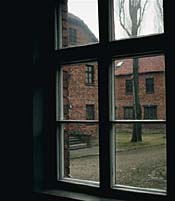![[ Instant Classics ]](../b_w_jpegs/IC_HEAD_LOGO.gif)


Soap Opera
By Harry Mathews
For Lynn Crawford
At a distance, the backlit object resembles a decorative table-top gadget, one that
must be upended to allow its load of small pellets to start cascading, through a
liquid as transparent and dense as shower gel, down an arrangement of slides, spiral
grooves, or more complex detours. Here the arrangement is that of a beehive, in which
each hexagonal cell allows passage through at least one, usually two, and sometimes
three of its walls. Emanating from a hidden source, the pellets, already discernible
at a distance as hollow rings, flood into the hive from above and slowly make their
way through the layers of cells (seventy-three in all), following courses that vary
from broken but essentially straight downward lines to elaborate, irregular paths
that may lead, for example, from one edge of the hive to the other and back. Whatever
its trajectory, each ring eventually drops from the bottom of the hive into the obscurity
below, an obscurity no less impenetrable than that from which the ring first emerged.
The variability of the paths is due to the unforeseeable speed and angle with which
a ring may strike the side of a cell or another ring, as well as by the erratic accessibility
of the aperture through which it will pass into the next cell.
As the viewer approaches the construction, it becomes apparent that something-something
relatively small-occupies the hollow of each ring. A still closer view reveals that
these presences, from afar seen as no more than specks, are in fact featherless bipeds.
The rings, it turns out, are not properly rings at all, since each has a depth at
least twice as great as its diameter: they are large cylinders, rather like truncated
sections of pipeline. The bipeds inside them seem at home in their mobile and indeed
unstable habitats. They adapt nimbly and naturally to the turnings of the cylinders
and the shocks occasioned by frequent collisions. They can clearly distinguish between
bouncing off a cell wall and encountering another cylinder. Such encounters evidently
inspire them with rejoicing or intense anxiety, according to their temperaments or
perhaps earlier experiences, and provoke in the great majority of cases a flurry
of activity specifically designed to make their reactions known to those whose paths
they happen to have crossed: tapping or pounding with their forearms against the
cylinder walls, rhythmic jumping or thumping with their feet, and some kind of articulate
falsetto shrieking (at least that is what an observer deprived of direct acoustical
evidence deduces it to be). Frequently two (sometimes more than two) cylinders will
be not only brought but kept together by chance, so that they share a common path
during the next stage of their journeying. In most instances this generally prompts
initial signs of tremendous satisfaction in one or both of the bipeds whose shells
are thus attached, although more often than not these signs of satisfaction tend
to disappear after a certain time. Be that as it may, sooner or later a difference
in the angle of rebounding, or a collision affecting one cylinder and not the other,
separates the two. Each inmate then, as before, concentrates exclusively on directing
the course of its cylinder's progress.
For such, indeed, is what each unmistakably thinks it is doing: by positioning itself
in a certain part of the cylinder, or by moving up and down its inner surface in
a deliberate manner, or even by performing virtually stationary actions that are
mechanically incomprehensible but may serve some propitiatory function, it is expressing
a conscious determination to control its itinerary through a maze whose disposition
remains beyond its sight and ken, as well as through a host of similar moving objects
whose very presence can be determined only haphazardly. Most cylinder inmates nevertheless
exhibit extraordinary and lasting confidence in this power to direct their own way;
and their confidence might be justified-all viewers have observed examples of prowess
in reacting to collisions and even, somehow, in anticipating them-if the openings
in the cell walls were arranged according to a pattern. Since in this respect great
care seems to have been taken to avoid all regularity, the results achieved by even
the finest maneuvers remain illusory beyond any but the briefest spans.
In time the strenuousness of the exertions required by this neverending struggle
for navigational mastery tires out the bipeds who inhabit the cylinders. Before their
containers have tumbled out of the lowest rank of cells, most have abandoned their
efforts or at least decided-and none but the coldest-hearted observer will fail to
sympathize with them-that the time has come for a well-deserved rest. It is in this
attitude of exhaustion or repose that we watch them disappear from view. Some, it
is true, labor to the end with an energy that cannot readily be interpreted as manifesting
either enthusiasm or despair. It remains impossible to judge whether their ultimate
fate merits such an expense, or whether it differs from that of their quieter brethren
to any significant degree. Most likely this notion belongs to the domain of pathetic
fallacy rather than to that of true possibilities, by which I mean those that a scrupulous
observer might reasonably entertain.
[ Home ] [ Contents ] [ Contributors ] [ Search ] [ Submit ]
![[ Instant Classics ]](../color_jpegs/quickmart2.jpg)
Instant Classics - The Culture Quick
Mart
©2007 Instant Classics

